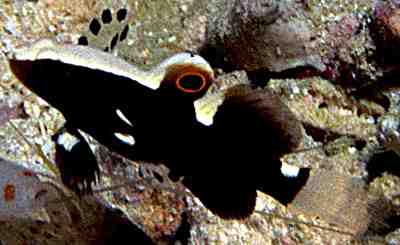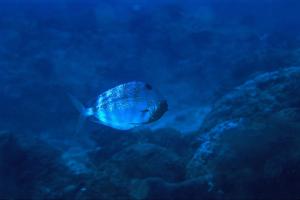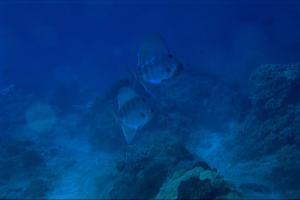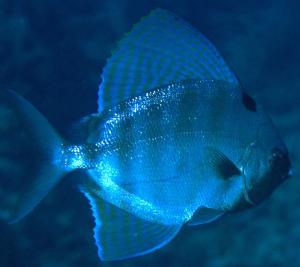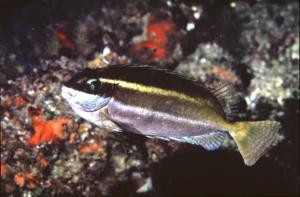

Conducted by

Sponsored by
News, News, and more Interesting Fish News
09/05/2002
South African Coelacanth Conservation and Genome Resource
Programme
You may have noticed that the Fish-Watch Project have been quite quiet over the last few months. This is because the Coelacanth Programme has been taking the lion's share of our time, planning the expedition and future of the Programme, motivating for funding, and recently, actually going on the expedition. It has kept us (Phil Heemstra and James Stapley, as well as many other staff members at SAIAB) more or less continuously occupied since September last year.
Our hard work paid off when we went along on the coelacanth expedition (25 March - 29 April) on the FRS Algoa. Phil got one dive in Jago, the submersible we were using, and is pretty certain he spotted a new species of Plectranthias, a small serannid fish. He also spotted a guitarfish (Rhinobatos annulatus, Natal colour morph) at several hundred meters - they were only really know from the surf zone previously, where they are most frequently encountered. I (James Stapley) have been quite busy updating and creating the coelacanth programme's own website. You might like to go there to learn more about what we have been doing. This was a very interesting experience over the relatively low bandwidth link I had over a cellphone - which also tended to get cut off in the middle of an upload while the ship turned! When we get a gap in our busy schedule, we will post some articles on the site for you to read - we are off to Natal again next week, and would love to join you at Aliwal Shoal 18/19 and 25/26 May for some Fish-Watch dives. Contact Mark Addison at Blue Wilderness ((039) 973 2348), or Underwater World in Durban ((031) 332 5820) for the Sunday dives.
We trust by now you have recieved your Rockcod Worksheet, number 7 in our series.
26/04/2001
Check out those chocolate gobies - by Dr. Helen K. Larson
Cryptocentrus
malindiensis and Lotilia graciliosa
Divers and underwater photographers who keep an eye out for those photogenic commensal shimp-gobies and their partners will probably be aware of the whitecap shrimp-goby, Lotilia graciliosa. This is one of the most elegant small fishes, being a distinctive velvety dark brown in colour, with a broad white stripe from its snout tip to the beginning of the first dorsal fin, which has a large round black spot edged with orange. The whitecap shrimp-goby is known from the Red Sea and across to Southeast Asia, Japan and northern Australia, but so far, this species has not been found south of the Red Sea. The species has been reported by divers at Sodwana Bay; however, it seems that what the divers at Sodwana saw, was actually the chocolate shrimp-goby, Cryptocentrus malindiensis Smith, 1959.
This is a rare goby, originally described by J.L.B. Smith from Malindi, Kenya; and apart from the original site, it is only known from Aldabra Atoll, Mauritius and the Seychelles. And only Smith’s original specimen is known in museum collections. The chocolate shrimp-goby looks very like Lotilia, being dark chocolate brown, with a broad creamy white band from its chin over the top of the head to end at the gap between the two dorsal fins. Its first dorsal fin is quite low and does not have the spectacular ocellate spot of the whitecap shrimp-goby. However, it is similar enough to trick a (nameless) scientist into misidentifying a photograph of it!
So, keep your eyes and cameras ready for the chocolate goby hunt. It would be very interesting to discover if the whitecap shrimp-goby’s distribution extends down the African coast outside the Red Sea, and just as exciting to learn more about the chocolate shrimp-goby, such as its preferred habitat and depth.
Dr
Helen K. Larson,
Curator of Fishes
Museum and Art Gallery of the Northern
Territory
PO Box 4646,
Darwin, NT 0801, AUSTRALIA
The shape of the head is also quite
distinctive - L. graciliosa has a pointed head, while C.
malindiensis has a much blunter snout which you can easily see in the
pictures. This, together with the length of the stripe on the head should make
it easy to tell the two species apart, even if all that you see is the head
sticking out of the burrow. (Ed.).
12/04/2001
Cyclichthys
spilostylus
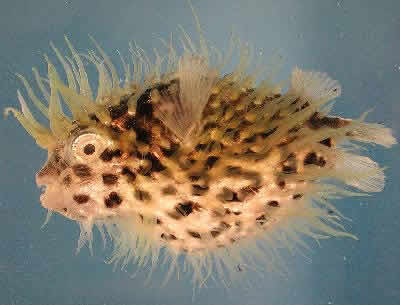

Common name: Yellow-spotted
burrfish
Scientific name: Cyclichthys spilostylus
Photographer: James
Stapley
This fish is the pelagic
juvenile stage of the yellow-spotted burrfish Cyclichthys spilostylus; we
had only read about this unusual form in books and never previously seen a
specimen, until one was brought to us yesterday by Mr. Horace Pittaway, a local
fisherman who found it struggling in a rockpool. The projections you see coming
off the body are soft, fleshy tentacles. As the fish grows, it loses the
tentacles and they are replaced by the hard spines more typical of this family.
You can see the small spines developing at the base of the tentacles above the
eye. We suppose that the tentacles are used as a sort of camouflage amongst
floating seaweeds (Sargassum) where they are thought to spend the
juvenile stage of their life. The adult is benthic (lives on the bottom) and
attains a size of 28cm. It is widespread from South Africa to the South China
Sea, Philippines and Australia.
20/02/2001
Velifer
hypselopterus
These are really important photos. We have never seen this fish underwater before. There are only two specimens in our fish collection, and these were collected by a trawler in 110 m off southern Madagascar. These photos document the first record of this species from southern Africa and on a coral reef. The species is also known from Oman, India, Japan, Vietnam, and Australia, but all of these records are based on trawl-caught fish taken in 50-200 m.
Fred Richardson of Rover Media Productions, who have produced the "Scuba Sodwana" CD tells us:
"The Velifer hypselopterus photos were taken a little East of 4-Buoy on 2-Mile reef in about 18m, 16 April 2000. The photographer is Mark van Coller who took most of our pics. That is also the only time anyone on our team saw them and I would guess that Mark and I put in at least 40 more dives on 4-Bouy subsequent to these pics (although most of these dives where inshore of 4-bouy)."
31/12/2000
Latimeria chalumnae - The
coelacanth
As you will no doubt
have seen in the press, a population of coelacanths has been found off Sodwana
Bay in northern Kwa-Zulu Natal. To read an article published in the South
African Journal of Science, and see pictures of the fish, please click here.
9/11/2000
Cirripectes
stigmaticus
Siganus luridus
Two more new distribution records from South Africa.

Common
name: Scarlet-spotted blenny
Scientific name: Cirripectes
stigmaticus
Photographer: Dennis
King
The colourful scarlet-spotted blenny, Cirripectes stigmaticus, was described from the Marshall Islands in the Pacific in 1953 by Strasburg & Schultz. In 1959, JLB Smith described Cirripectus [sic] cruentatus as a new species, based on one specimen from Pinda Mozambique because it"differs from other species in markings". It is often risky to describe a new species based on a single specimen, because we cannot know the variation in colour and other characters of some species without a sample that includes adults and juveniles, males and females. It so happensthat the colour pattern of the scarlet-spotted blenny varies quite a lot: some fish are mostly covered with scarlet spots, and others have just a few. Females have a rust coloured reticulation enclosing pale olive spots, and the males have scarlet spots and lines on the rear part of the body. When Jeff Williams revised the blenny genus Cirripectes in 1988, he determined that Smith's species (C. cruentatus) is the same species as C. stigmaticus. So the species' distribution was extended from the central Pacific to Mozambique, Kenya, Tanzania, Comores, Madagascar, Maldives, Mauritius, St Brandons Shoals, and Sri Lanka.
As a result of Dennis
King's excellent photo of a specimen at Sodwana, we can now add
South Africa to the range of this lovely blenny.


